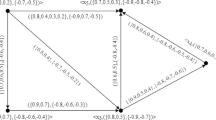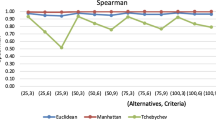Abstract
Given a finite set X and a collection Π=(R 1,R 2,…,R v ) of v binary relations defined on X and given a remoteness ρ, a relation R is said to be a central relation of Π with respect to ρ if it minimizes the remoteness ρ(Π,R) from Π. The remoteness ρ is based on the symmetric difference distance δ(R i ,R) between R and the binary relations R i of Π (1≤i≤v), which measures the number of disagreements between R i and R. Usually, the considered remoteness between Π and a relation R is the remoteness ρ 1(Π,R) given by the sum of the distances δ(R i ,R) over i, and thus measures the total number of disagreements between Π and R or, divided by v, provides the (arithmetical) mean number of disagreements between Π and R. The computation of a central relation with respect to ρ 1 is often an NP-hard problem when the central relation is required to fulfill structural properties like transitivity. In this paper, we investigate other types of remoteness ρ, for instance the sum of the pth power of the δ(R i ,R)’s for any integer p, the maximum of the δ(R i ,R)’s, the minimum of the δ(R i ,R)’s, and different kinds of means of the δ(R i ,R)’s, or their weighted versions. We show that for many definitions of the remoteness, including the previous ones, the computation of a central relation with respect to ρ remains an NP-hard problem, even when the number v of relations is given, for any value of v greater than or equal to 1.
Similar content being viewed by others
References
Alon, N. (2006). Ranking tournaments. SIAM Journal on Discrete Mathematics, 20(1), 137–142.
Arrow, K. J. (1951). Social choice and individual values. New York: Wiley. See rather the revised edition of 1963.
Barthélemy, J.-P. (1979). Caractérisations axiomatiques de la distance de la différence symétrique entre des relations binaires. Mathématiques et Sciences humaines, 67, 85–113.
Barthélemy, J.-P., & Monjardet, B. (1981). The median procedure in cluster analysis and social choice theory. Mathematical Social Sciences, 1, 235–267.
Bartholdi, J. J. III, Tovey, C. A., & Trick, M. A. (1989). Voting schemes for which it can be difficult to tell who won the election. Social Choice and Welfare, 6, 157–165.
Bouyssou, D., Marchant, T., Pirlot, M., Tsoukias, A., & Vincke, P. (2006). Evaluation and decision models with multiple criteria. Berlin: Springer.
Brandt, F., Conitzer, V., & Endriss, U. (2013). Computational social choice. In G. Weiss (Ed.), Multiagent systems (pp. 213–283). Cambridge: MIT Press.
Caspard, N., Monjardet, B., & Leclerc, B. (2012). Finite ordered sets: concepts, results and uses. Cambridge: Cambridge University Press.
Charbit, P., Thomassé, S., & Yeo, A. (2007). The minimum feedback arc set problem is NP-hard for tournaments. Combinatorics, Probability & Computing, 16(1), 1–4.
Charon, I., & Hudry, O. (2010). An updated survey on the linear ordering problem for weighted or unweighted tournaments. Annals of Operations Research, 175, 107–158.
Conitzer, V. (2006). Computing Slater rankings using similarities among candidates. In Proceedings of the 21st national conference on artificial intelligence (AAAI-06), Boston, MA, USA (pp. 613–619).
Cormen, T., Leiserson, C., & Rivest, R. (1990). Introduction to algorithms. Cambridge: MIT Press.
Dwork, C., Kumar, R., Naor, M., & Sivakumar, D. (2001). Rank aggregation methods for the Web. In Proceedings of the 10th international conference on world wide web (WWW10) (pp. 613–622).
Garey, M. R., & Johnson, D. S. (1979). Computers and intractability, a guide to the theory of NP-completeness. New York: Freeman.
Hemaspaandra, E., Spakowski, H., & Vogel, J. (2005). The complexity of Kemeny elections. Theoretical Computer Science, 349, 382–391.
Hudry, O. (1989). Recherche d’ordres médians: complexité, algorithmique et problèmes combinatoires. PhD thesis, Télécom ParisTech, Paris.
Hudry, O. (2008). NP-hardness results on the aggregation of linear orders into median orders. Annals of Operations Research, 163(1), 63–88.
Hudry, O. (2009a). Complexity of voting procedures. In R. Meyers (Ed.), Encyclopedia of complexity and systems science (pp. 9942–9965). New York: Springer.
Hudry, O. (2009b). A survey on the complexity of tournament solutions. Mathematical Social Sciences, 57, 292–303.
Hudry, O. (2010). On the complexity of Slater’s problems. European Journal of Operational Research, 203, 216–221.
Hudry, O. (2012). On the computation of median linear orders, of median complete preorders and of median weak orders. Mathematical Social Sciences, 64, 2–10.
Hudry, O. (2013, to appear). Complexity of computing median linear orders and variants. Electronic Notes in Discrete Mathematics.
Hudry, O., & Monjardet, B. (2010). Consensus theories. An oriented survey. Mathematics and Social Sciences, 190, 139–167.
Hudry, O., Leclerc, B., Monjardet, B., & Barthélemy, J.-P. (2009). Metric and latticial medians. In D. Bouyssou, D. Dubois, M. Pirlot, & H. Prade (Eds.), Concepts and methods of decision-making process (pp. 771–812). Berlin: Wiley.
Kemeny, J. G. (1959). Mathematics without numbers. Daedalus, 88, 577–591.
marquis de Condorcet, M. J. A. N. Caritat (1785). Essai sur l’application de l’analyse à la probabilité des décisions rendues à la pluralité des voix. Paris: Imprimerie Royale.
Slater, P. (1961). Inconsistencies in a schedule of paired comparisons. Biometrika, 48, 303–312.
Wakabayashi, Y. (1986). Aggregation of binary relations: algorithmic and polyhedral investigations. PhD thesis, Augsburg, Germany.
Wakabayashi, Y. (1998). The complexity of computing medians of relations. Resenhas, 3(3), 323–349.
Acknowledgements
I would like to thank Fred McMorris for the question he set me during a DIMACS workshop at the university of Paris-Dauphine about considering an unusual remoteness to define central relations.
Author information
Authors and Affiliations
Corresponding author
Additional information
Research supported by the ANR project “Computational Social Choice” and the ANR project “Computation, Communication, Rationality and Incentives in Collective and Cooperative Decision Making”.
Rights and permissions
About this article
Cite this article
Hudry, O. Complexity results for extensions of median orders to different types of remoteness. Ann Oper Res 225, 111–123 (2015). https://doi.org/10.1007/s10479-013-1342-3
Published:
Issue Date:
DOI: https://doi.org/10.1007/s10479-013-1342-3




